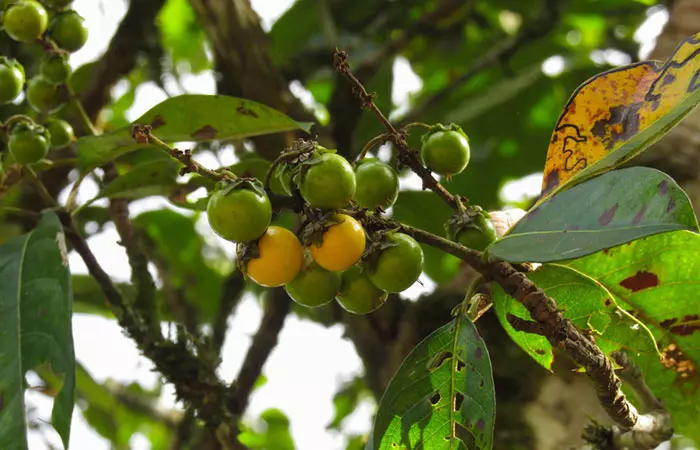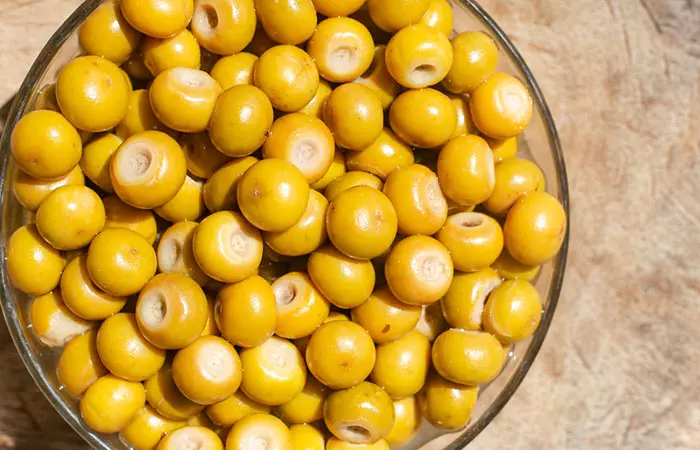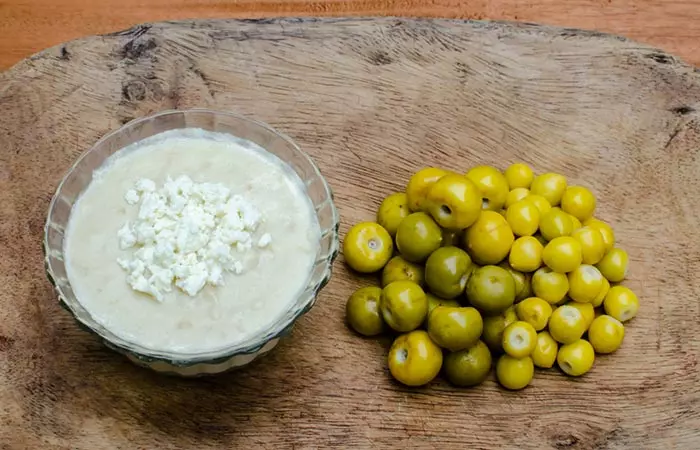What Is The Nance Fruit?
Nance is a cherry-sized yellow or red berry that grows wild in the Central and Latin Americas and the Caribbean. It is also referred to as nanche, hogberry, or yaca. It is sweet and pungent and has a big pit containing one to three seeds nestled within its whitish, creamy, and oily pulp. The fruit can sometimes taste acidic or bitter as well. What sets the nance fruit apart though is its distinctive smell. Some describe it as soapy, while others can’t quite describe it. Who Can Consume It? The nance fruit is safe to be consumed by all. How Often? One cup of nance fruit can be consumed daily. Caution If you are allergic to acerola cherries, avoid consuming the nance fruit.
Since nance is a unique fruit, not everyone likes its smell and taste. Cee, a blogger, tried it for the first time and did not like its taste. She said “I thought they smelled soapy and like something else familiar but not quite pleasant. I figured it out a bit later. They smelled like fruitcake! But not sweet yummy fruitcake but like old crappy fruitcake with too much allspice and cloves (i).” Nances grow on the nance tree (Byrsonima crassifolia), a flowering shrub that thrives in backyards, open forests, and savannas. Nances are used in jams, popsicles, preserves, desserts, beverages, and even savory dishes. You can even eat it straight off the tree. The nance is generally yellow, but you can find a red variety (commonly called guajacote) in Mexico and Costa Rica.
Nutritional Profile Of The Nance Fruit
You can cook with nances or eat them raw. Either way, the fruit has a lot to offer in terms of the macro- and micronutrients (1). The nance fruit is loaded with vitamin C and dietary fiber. It is also replete with carotenoids and minerals. Its rich nutrient profile makes the nance fruit quite beneficial for human health. We discuss its health benefits in the following section.
5 Potential Health Benefits Of The Nance Fruit
- May Promote Gut Health The dietary fiber in nance may help improve symptoms associated with irritable bowel syndrome, Crohn’s Diseasei A chronic inflammatory bowel disease that causes irritation in the digestive tract, leading to abdominal pain, diarrhea, and fatigue. , ulcerative colitisi A long-term inflammatory bowel disease that can cause inflammation and ulcers in the digestive tract. , and chronic constipation. Half a cup of the nance fruit can offer 4 grams of dietary fiber. That is 16% of the daily value for a 2000-calorie diet as prescribed under the Dietary Guidelines for Americans (2). Dietary fiber can do wonders for digestion and the overall intestinal environment as the friendly gut bacteria feed and thrive on it. Dietary fiber, especially from whole fruits, can also lower the risk of various diseases associated with the gastrointestinal tract (3).
- May Help Maintain Skin Health Have a cup of nance fruit and you are on top of your required vitamin C intake for the day. Vitamin C is linked with increased collagen production and helps reduce photo UV damage. It may help keep your skin youthful and resilient against environmental damage. The antioxidant-rich profile of nance fruit helps fight against free radicals and reduces the chances of premature skin aging (4). Nances also contain vitamin E that is quite popular in the cosmetic industry. Vitamin E stabilizes the skin barrier and protects it from photodamage. Although further studies are required, vitamin E may help reduce the risk of skin cancer and UV damage (5). This vitamin also reduces inflammation and may help in the treatment of eczemai A long-term inflammatory condition that causes itchy, red, bumpy, cracked skin and rashes along with soreness. or acne (6). The combination of vitamin C and vitamin E is effective in reducing skin damage and regenerating healthy skin (7). While the effects of vitamins C and E have been well studied, further research on the nance fruit and its skin benefits is warranted.
- May Reduce Risk Of Heart Disease The dietary fiber in nances may help regulate blood pressure, blood cholesterol, and triglyceride levels (8). Studies suggest that soluble fiber can reduce levels of low-density lipoprotein (LDL) by obstructing its absorption. LDL cholesterol is often responsible for high blood pressure and may also increase the risk of stroke (9). Another study has found that eating at least 25 grams of fruit with white flesh may reduce the risk of heart attack (or stroke) by 9 percent (10).
- May Help Counter Lead Toxicity Vitamin C in nances may help reduce the effects of lead accumulation in the body. Lead poisoning increases oxidative stress and disrupts bodily functions. In a study, exposed battery workers (with high blood lead levels) on vitamin C supplementation had reduced levels of oxidative stress and increased antioxidant status. While vitamin C may not lower blood lead levels, it may help reduce the associated oxidative stress (11).
- May Reduce Cancer Risk Vitamin C in nances may reduce the risk of lung, mouth, stomach, rectum, throat, and esophageal cancers (12). In a study, terminal cancer patients given supplemental vitamin C had improved quality of life and longer survival periods (13). The dietary fiber in nance fruit may also reduce the risk of colon cancer. Dietary fiber may also decrease the risk of gastrointestinal cancers and cancers of the breast, ovary, and endometrium (14). Nance fruit has not been studied individually as a potential anti-cancer food. But there is substantial evidence to suggest that the selenium and carotenoidsi A class of naturally-occurring pigments found in many fruits and vegetables with anti-inflammatory and antioxidant properties. in the fruit play a protective role in cancer prevention. Nances are rich in lutein and alpha- and beta-carotenes as well that may have anti-cancer potential (15), (1). This graph shows the analgesic activity of Byrsonima crassifolia. The hot plate test revealed that both the hydroalcoholic and dichloromethane extracts of B. crassifolia produced dose-dependent analgesia. The analgesic effect produced by the extracts under study was compared with that of acetylsalicylic acid (standard), and both hydroalcoholic extract and the dichloromethane presented a slight analgesic activity 30 minutes after administration.
Analgesic Activity Of The Extracts Of Byrsonima crassifolia
So how do you get all these benefits from nance?
How To Add The Nance Fruit To Your Diet
If you live in Central or Latin America or the Caribbean, chances are you will easily find fresh nance fruits. If not, you may always look at international or frozen food sections of your nearest supermarket. You can identify nances by their smooth and thin golden yellow, orange or red peel and a distinctly strong odor. You may eat them raw (discard the pit with seeds) or cook them to prepare delicious meals. Nances also do well in smoothies and fruit salads. In Mexico, locals enjoy nances with a sprinkle of chili powder and a squeeze of lime. If you know how to make marmalade, you can prepare a batch with nances. Nances also work great as a vinegar pickle or jam. They are quite versatile as they are used in desserts and savory dishes. If you are looking to satisfy your sweet tooth, you can add sliced nances to a one-pot meal of chicken, olives, and rice. Let’s check out one popular recipe using nances that you can prepare at home.
Popular Recipe Using Nances
There are many different ways to enjoy nances. Pesada de nance, a recipe from Panama, is quite popular among kids and adults. It is also easy to prepare.
Pesada De Nance
This is a traditional recipe that uses the pulp from tart nance fruits, water, cornstarch, and sugar. It is a smooth cream that can be served hot or cold with crumbly and salty fresh cheese on top. Preparation Time 15 minutes Cooking Time 12 minutes Ingredients
8 cups of nance 3 liters of water ¾ cup of water 1 cup of cornstarch Optional: 1 lime/a handful of pineapple chunks
Process
Safety Precautions To Be Considered While Eating Nances
Nances have not been studied widely or extensively. Hence, not much is known about how these fruits may interact with medications or specific health conditions. You can consult your doctor if you are worried about including nances in your diet. In case you are allergic to acerola cherries, you may want to steer clear of nances (as the two belong to the same Malpighia plant family). What happens if you swallow a nance seed? Swallowing one or two nance seeds may not cause any harm. However, excess intake may cause intestinal obstruction or blockage. If you experience any discomfort, fever, or pain, seek medical help immediately. Can dogs eat nance fruit? Yes, dogs can eat nance fruit. However, the seeds may choke and cause intestinal obstruction in a few. Take proper precautions if you plan to feed the nance fruit to your pet dog. Can nance fruit support immune system function? Nance fruit is an excellent source of vitamin C, which may help boost the proper functioning of the immune system (1), (16). Does nance fruit have any anti-inflammatory properties? Yes. An animal study observed that the extracts of nance fruit seeds exhibit anti-inflammatory properties (17). Can nance fruit aid in digestion? Yes, it is rich in digestive fiber, which improves the health of your digestive system and promotes regular bowel movements (1), (18).
Illustration: Nance Fruit: A Strange Fruit With Strong Potential
Watch this informative video to uncover the incredible nutrition, benefits, and precautions of nance fruit. Discover how this tropical gem can enhance your health and lifestyle. i. A new fruit — nance https://chasingmarbles.blogspot.com/2018/05/a-new-fruit-nance.html













